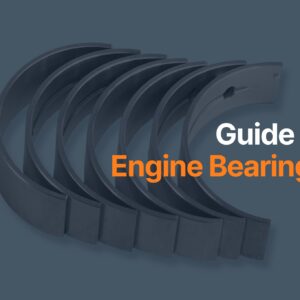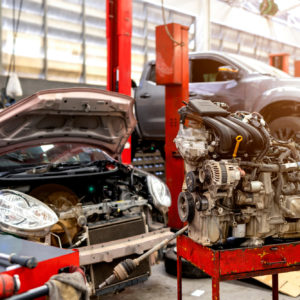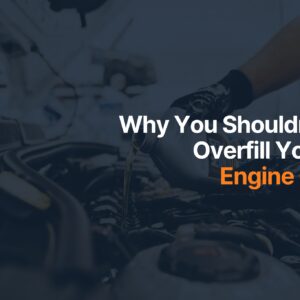If a vehicle is left unused for years, the cylinder walls and piston rings can develop rust. When this happens, the pistons can stick to the cylinder walls, preventing them from moving. These components are quite prone to seizing because of the tight tolerance present between the cylinder wall and piston rings.
You’ll need to free the stuck pistons from the cylinders if you intend to rebuild or restore the engine. Fixing a seized engine might seem like a hopeless task since rust can make the whole cylinder and piston assembly seem like one fused part. Luckily, there are solvents that can penetrate the rust and free the seized engine components. Here’s some tips on how to remove rust from inside an engine block.
Soak in Vinegar
If you’re wondering how to remove rust from your car’s engine, you might try using some vinegar. Vinegar is a very good solvent because it contains acetic acid, which dissolves rust.
In fact, vinegar could be the best way to remove rust from an engine block because it’s quite affordable compared to other solutions.
The process involves pouring white vinegar into the cylinder. There’s a good chance the seized piston and cylinder can hold the white vinegar like a glass. Leave the cylinder and piston like this and refill the vinegar daily as it can dry out. Alternatively, you can put the engine block in a large tank or reservoir and fill it entirely with white vinegar. After a few days, the rust should soften enough for it to be brushed and scraped away easily. The rust might have also softened enough for you to pull the pistons from the engine block.
Other Household Alternatives
- Lemon Juice and Salt: Mix salt water and lemon juice in concentrated form and pour it in the cylinder so it can make its way down to the piston ring/cylinder wall contact areas.
- Baking Soda Paste: Mix baking soda with water to create a thin paste and fill the cylinder with it so that it can seep down around the piston rings and soak. Baking soda is alkaline, which is the opposite of acid but will work the same way.
Soak in Rust Remover
You can also soak the engine block in rust remover in the same fashion as vinegar. Pour the rust remover into the cylinder hole and let it sit for a few days.
So, what is “rust remover,” exactly? Try diesel fuel, kerosene, automatic transmission fluid, PB Blaster, WD40, and there are many products on the market. Most of all, you need to let it work. Time is a crucial element of this process, so be patient and let the stuff do its work while you find something else to do.
Soak in Automatic Transmission Fluid and Acetone
A mix of automatic transmission fluid (ATF) and acetone is also a solution that can penetrate rust and break apart seized components. The ATF and acetone are usually mixed in equal parts. Like the rust remover and vinegar, you’ll need to cover the rusted surfaces with the mix. Placing the engine block and pistons in a tub and dousing the parts with the mix would be ideal.
Pound the Piston with a Rubber Mallet
If the pistons don’t break apart from the engine block on their own after being submerged in the solutions after a day or two, you’ll need to break the piston loose.
You can use a piece of wood and a rubber mallet to do this. Place the piece of wood on top of the piston and tap the wood with a rubber mallet.
You can also use a steel hammer and a piece of wood, which will work better than a rubber mallet. Avoid the center of the piston. Only apply the percussion to the edges or you may crack the piston (of course, once you get the old pistons out, you’ll want to replace them with new pistons anyway, so there’s that.)
If the pistons won’t budge from being hammered from the top, you can turn the engine block upside down so that you can try to hammer the piston from underneath. To give the pistons more wiggle room, you should try to remove as much excess rust around the cylinder wall using a metal brush.
Sometimes, the piston will move slightly but remain seized. If this is the case, the engine block and pistons need more time to soak. Generally speaking, the solution will dissolve more rust the longer the metal is soaked.
How to Keep an Engine Block from Rusting
If your engine is still part of a functioning vehicle, its engine block and pistons will be protected from rust by engine oil. That said, you’ll need to start the engine regularly so that the internal components are still going to be coated with oil.
But an engine that has been sitting fallow for a long time tends to dry out the cylinder walls and will eventually allow them to rust if it sits long enough, because moisture tends to get into cylinders with open valves.
The engine oil will only be able to protect the engine as long as it’s regularly used or started. Salvage yard engines (at some yards) will have the spark plugs removed and some automatic transmission fluid squirted through the spark plug port into the cylinder, and then the plugs will be reinstalled. This prevents the piston rings from rusting to the cylinder walls to begin with.
When an engine sits unused, oil and lubricants will collect at the bottom, depriving the engine’s metal components of oil. The lack of oil is eventually going to expose your engine’s metal components to air or humidity, which will cause rust to form.
You can also do the following as added measures:
- Store your vehicle in a dry and well-ventilated space.
- Cover your vehicle with a protective cover.
If you have an engine block in storage that you plan on rebuilding at a later date, you need to protect the exposed steel from rust. Covering all its surfaces with gear oil or WD-40 will ensure that there’s a layer of oil protecting the metal from making contact with oxygen in the air. Moreover, you should place a plastic bag over the motor since you don’t want any dust or dirt to get on the metal, as this can also cause rust to form.
Finding Replacement Pistons for Your Vehicle
If your pistons don’t work as intended even after unseizing them and removing all the rust, it might be time to replace them. It can be tricky to shop for replacement parts online, but with the help of CarParts.com, finding pistons compatible with your vehicle has never been easier.
Our pistons are manufactured by some of the most trusted names in the industry. Items in our catalog are handpicked by our team of professionals. You won’t have to worry about your new pistons failing you any time soon.
The best part? Our products are sold at competitive prices, meaning necessary repairs won’t have to break the bank.
To get started, use your mobile device or computer to visit our website. Input all of your vehicle’s details such as the year, make, model, and engine with the vehicle selector. This way, you can easily find auto parts designed to work with your vehicle.
With our distribution centers strategically located all over the US, you’ll receive your order in just a few days.
Don’t hold off on getting replacement pistons for your vehicle. Browse our collection today.
Any information provided on this Website is for informational purposes only and is not intended to replace consultation with a professional mechanic. The accuracy and timeliness of the information may change from the time of publication.







































